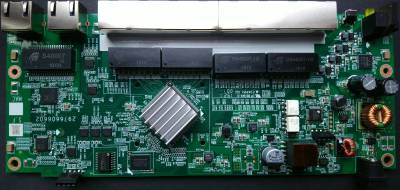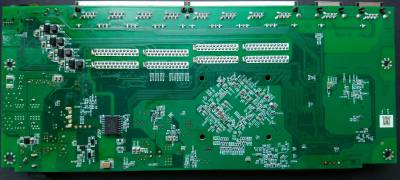This is an old revision of the document!
Netgear GS110TPP
The GS110TPP is a 10-port managed gigabit switch. Eight ports support PoE+, with a standard total power budget of 120W.
Hardware build-up
The switch is built up around the RTL8380M SoC. To access the CPU's serial console on UART0, header J1 is available with 3.3V logic, 115200 baud, and 8n1 bits. Firmware is stored in 32MiB SPI flash (Macronix MX25L25635F) and the device has 256MiB of DDR3 RAM (Winbond W631GG8MB).
Ethernet ports are split up between the SoC's internal switch and an external RTL8214C phy. The internal switch connects to port 1-8, while the external phy connects to port 9-10. The external phy is linked to the SoC via a QSMII link. Ports 1-8 can also provide power according to 802.3.at (PoE+) and PoE is controlled by the BCM59121. PoE management is done by an auxiliary Nuvoton M0516LDN microcontroller. Communication with the Poe-CPU happens via a serial port, connected to the main CPU's UART1. Optocouplers are used to isolate the two circuits from each other and the communication frames can be sniffed from J3 (3.3V, 19200 baud, 8n1).
To indicate the global device status, two LEDs are present on the front panel. One is labelled 'PoE Max', and is likely controlled directly by the BCM59121. The other is labeld 'Power', and is used to indicate the device status. This LED appears to be an RGB LED, although it is currently unclear how the three colours are controlled. All ports have a two-pin bi-color LED, used to indicate the link status: green for 1000M, orange for 100M. These are driven by three SN74HC164 shift registers, using 20 of the 24 outputs available. PoE status bi-color LEDs are also available, with green used to indicate the remote device is PoE powered, and orange to signal a PoE fault status. The PoE-status LEDs are driven by two SN74LV595A shift registers.
Extra GPIOs are provided by an external RTL8231, as is common on this platform.
Board pictures
Pinouts
GPIO
- TP8: GPIO2
I2C
- TP1: CLK
- TP2: DAT
JTAG
- TP3: #TRST
- TP4: TDI
- TP5: TDO
- TP6: TMS
- TP7: TCK
MDIO
- Between R163/C41: MDIO
- Between R165/C43: MDC
Serial console
- J1.1: 3.3V via R9 (not populated)
- J1.2: RX
- J1.3: TX
- J1.4: GND
Serial PoE control
This connector is in the PoE power domain, which is isolated from the power domain of the SoC. Be careful when connecting to this port and use a digital isolator.
- J3.1: VCC (appears not connected)
- J3.2: RX
- J3.3: TX
- J3.4: GND
Firmware
| Flash layout | |||||||
|---|---|---|---|---|---|---|---|
| Name | u-boot | u-boot-env | device-info | config | log | firmware1 | firmware2 |
| Size | 896k | 64k | 64k | 1M | 1M | 14.5M | 14.5M |
Bootloader
U-Boot is used as bootloader for this device, and has access to a modifiable u-boot-env partition. This can be used to store modified and custom environment variables.
Some realtek-specific commands are also available:
rtk network on: Configure the ethernet hardware inside the bootloader (not enabled on boot).

